Сообщества › Околоколесица (мотоциклы, ATV, гидроциклы) › Блог › История гусеничных мотоциклов
![]()
В основе этой статьи — переработанная и дополненная статья из одного из ЖЖ.
Начнем. 24 июля 1900 года Генри Стис (Henry Stith) получил патент на такой велосипед:
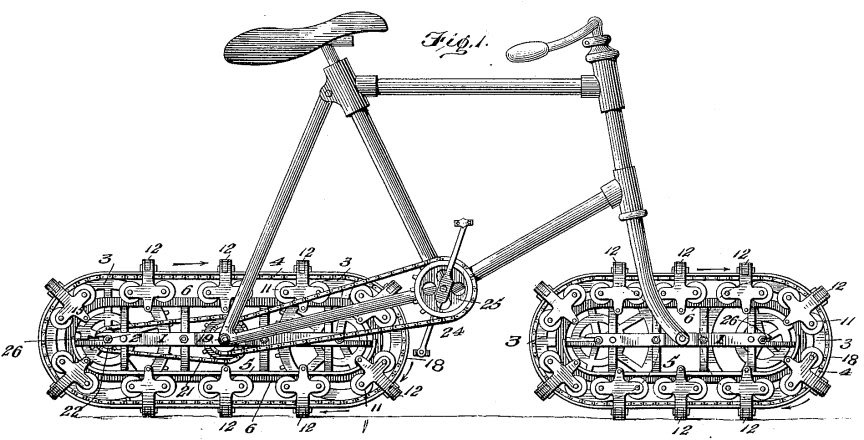
На момент написания статьи в журнале Популярна Мехника (Popular Science) за июнь 1944, у сына Stith-а все еще был этот велосипед, который Генри построил для него. Позже, изобретение пропало бесследно…
RASC Triumph. Великобритания. 1927.
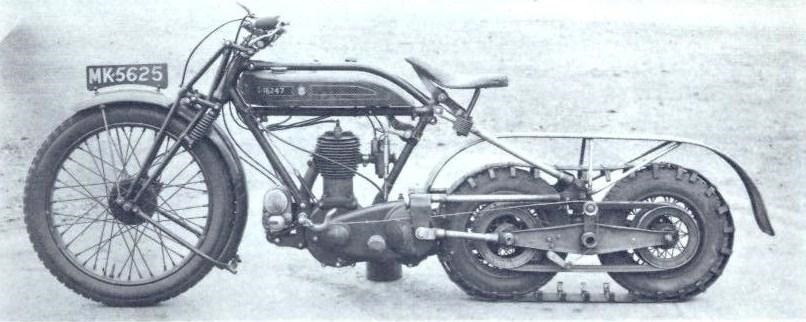
Этот оригинальный трехколесный мотоцикл с движителем 3×2 был создан в 1926 году на базе Triumph 500 SV Модель P Mk2. Он был пределан из обычного по заказу Service Corps королевской армии (RASC), и изготовлен в одном экземпляре. Не известно, как он показал себя на испытаниях, но хочется предположить, что внедорожные способности были неплохими. Идея не получила развития из-за совершенствования конструкции обычныхмотоциклов. RASC Triumph сейчас хранится в музее транспорта армии (Museum of Army Transport, Beverley) в Великобритании, и они сожалеют, что вряд ли он когда-либо будет полностью восстановлен и продемонстрирован, потому что они не в состоянии найти аутентичные 11″ дюймовые шины задних колёс.
Так выглядел стандартный Triumph SD, 1-cyl. SV 500cc, 1921-1927 гг.
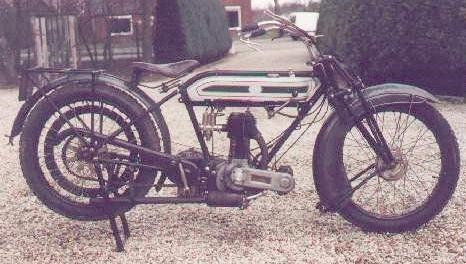
OEC. Великобритания. 1928 год.
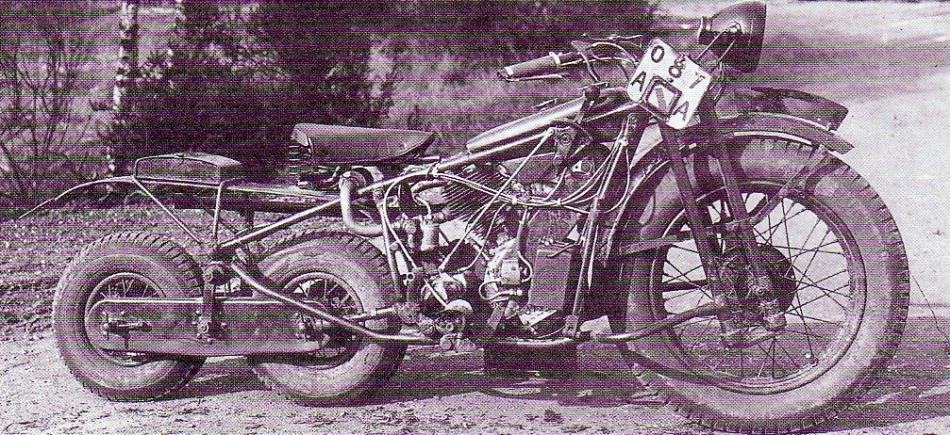
Компания OEC (Osborn Engineering Co.) располагалась в Gasport, Hants, Великобритания. В 1928 году она изготовила два прототипа гусеничных мотоциклов. Такой байк мог эксплуатироваться как с гусеницей поверх колёс задней тележки, так и без нее. Второе заднее колесо было связано внутренним зубчатым ремнем с цепным приводом первого колеса. Машины были предложены армии и частным покупателям как тракторы. Компания уже готова была продавать такие мотоциклы, но проект никого не заинтересовал.
Tractorcycle. Италия. 1931 год.

“Итальянский полугусеничный мотоцикл на манёврах близ Рима. 1931 год.” согласно информации из Большой Советской Энциклопедии.
На самом деле впервые фото было напечатано в журнале Популярная Механика (Popular Science), за февраль 1931. Этому мотоциклу, даже посвящена статья “Tractor cycle for rough ground” (Трактор цикл для бездорожья). Подпись к фото: “Итальянская милиция испытывает мотоцикл совместно с “боевым танком”, в качестве индивидуального средства передвижения по пересеченной местности. Они находят его превосходство над лошадьми в скорости передвижения.”
Victoria. Германия. 1930-е.

Гусеничный мотоцикл с движителем 3×2, 3-х местный, производство Victoria-Werke AG в Нюрнберге. 1930-е.
В основу лег вот этот Victoria Boxer модель KR VI.

Технические характеристики гусеничного мотоцикла Victoria:
Год выпуска: 1927 — 1932
Максимальная скорость: 120 км / ч
Четырехтактный двигатель — оппозитный двигатель
Количество цилиндров: 2
Объем: 596 см3
Диаметр/Ход поршня: 77 мм х 64 мм
Мощность/оборотов: 18 л.с. / 4000 мин-1
24 л.с. спортивная модель
Количество передач: 3
Независимая передняя амортизационная вилка патент Victoria.
Шины 26 х 3 и 27 х 3,5
BMW Speziel TR500 с коляской “Sneekrad”. Германия. 1936 год.
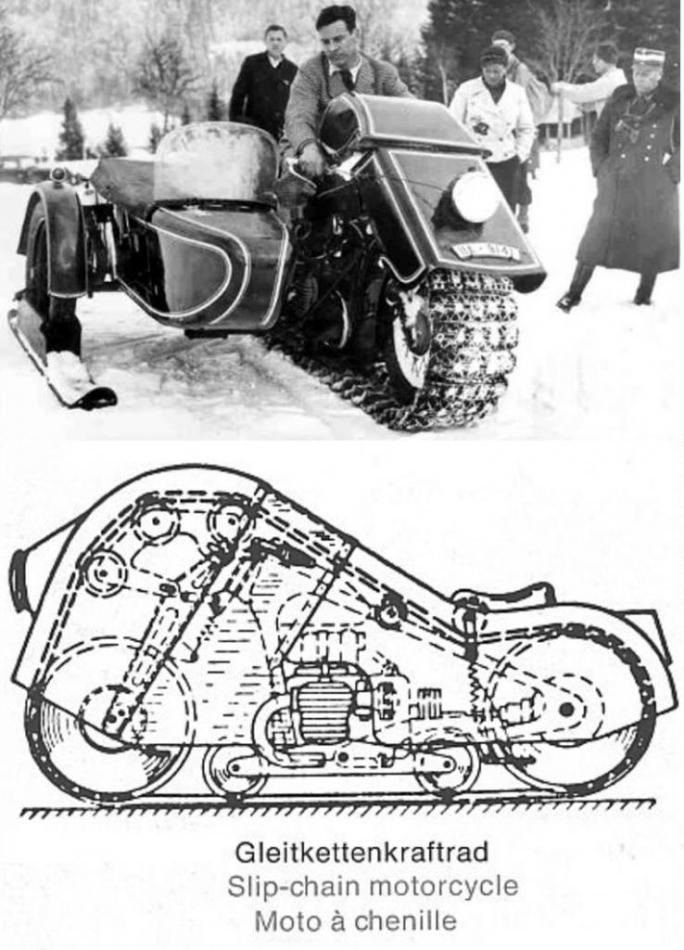
BMW Speziel TR500 “Sneekrad” создан по заказу Вермахта на базе популярной модели BMW R12 инженером Riemerschmidt в 1936 году, в одном экземпляре. Как управлять этим агрегатом? Можно предположить, что очень сложно.
Мотоциклы Мерсье Motochenilles. Франция. 1937 год.

Мерсье Motochenilles Тип 1. Мотоцикл Мерсье с передней гусеницей был создан в 1937 году в Буа-Коломб, Франция. Мерсье получил заказ от швейцарской армии и создал этот прототип для испытаний. Так получилось, что испытывался он не для швейцарской, а для французской армии. Двигатель объемом 350 см3 и мощностью 11 л.с. был слабоват, хотя позволял подниматься на склоны крутизной до 42°. Коробка передач 3-х ступенчатая. Всего было изготовлено 3 прототипа разных типов для французской армии.

Продолжение статьи “История гусеничных мотоциклов” в группе Два колеса — мотоциклы, мотороллеры, скутеры
Suzuki Colleda
You couldn’t find any Suzuki stickers or emblems on the motorcycles Suzuki built on the early models. No, the early models were given the name Colleda and the famous Suzuki ”S” appeared for the first time in 1959 and the Colleda brand name was replaced by Suzuki in the early 1960’s, the T10 being the first non-Colleda. Here’s some of the Suzuki’s Colleda models from the fifties and early sixties. I will add more models here when I find suitable pictures and some facts.
Contents
1954 [ edit ]
Apparently the word “Colleda” means something like “This is it!” or “This is the one!” in Japanese. The Japanese use that word when they find something special (the best) they have been looking for. (Thanks, Takeshi!)
Suzuki Loom Manufacturing Company (SJK) presented the side-valve powered Colleda CO in May 1954, the first real motorcycle from Suzuki. The single-cylinder 90cc four-stroke engine developed four horsepower and ran quite smoothly, thanks to its heavy fly wheel, attached to ignition magneto.
No driver’s license was needed at the time for riding the Colleda CO. The Japanese government had recently decided that no driver’s license were longer needed to ride a bike with an 4-stroke engine up to 90cc or a 2-stroke engine up to 60cc. That explains rather well Suzuki’s choice of engines for its first models on the market in 1954 – the Diamond Free motorized motorcycle with 58cc 2-stroke engine with 2 hp and the 90cc four-stroke with 4 hp.
The Colleda CO had a steel frame, telescopic front fork, shock absorbers on the rear wheel and coil spring-suspensioned seat. It had no turning lights but it did have a headlight and a rear light. It was the first Japanese motorcycle provided with a speedometer, built in the headlight. The built-in gearbox had three speeds. One source claim that the model had hydraulic brakes but I haven’t been able to confirm this.
The rigid frame and luggage carrier made the bike suitable for carrying of goods. They say that the 90cc Colleda sounded more than it actually performed, but the ”sound effects” and the rigid construction made the bike quite popular among Japanese customers.
Engine type: 90 cc side-valve single cylinder four-stroke. 4 hp.
1955 [ edit ]
It was not longer allowed to ride a 90cc four-stroke without a driver’s license in 1955 and that naturally affected the sales figures in negative direction. The 90cc Colleda CO must be one of the absolute rarest motorcycles Suzuki ever built. The model was soon discontinued and replaced by the 125cc version. But the four-stroke machines at the time were not as reliable as the more simple two-stroke machines and soon Suzuki discontinued even the 125 model. All the forces were concentrated in developing two-stroke engines. It took actually over 20 years before Suzuki built four-strokes again, after an unsuccessful attempt of using Wankel rotary engines.
The four-stroke models got company by the 102cc Porter Free and 123cc ST during 1955. Both models were two-strokers with steel frame, telescopic front forks and plunger rear suspension, similar to their predecessors. All of the Colleda two-stroke engines used the conventional piston valve construction, the rotary (reed) valve engines came much later.
The ST was the most successful of the models. It was a simple and affordable small motorcycle that was in sales of the model exceeded 100,000 units during the six years it was manufactured.
Colleda COX 1955 [ edit ]
Dry Weight: Engine type: 123 cc side-valve single cylinder four-stroke. Three speeds, telescopic front forks and plunger rear suspension.
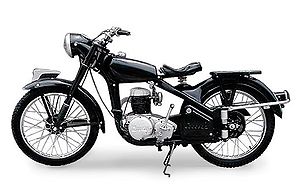
Colleda ST 1955 [ edit ]
- Dry Weight: 95 kg (205 lbs)
- Engine type: Air-cooled 123.18 cc single cylinder piston-valve 2-stroke. 5,5 hp.
- Maximum Speed: 65 kph
- Bore and stroke: 52.0 x 58.0 mm
- Compression ratio: 9.5:1
- Clutch: wet multiple plate
- Gears: 4
- Tyres: 2.50-19
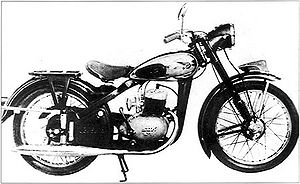
1956 [ edit ]
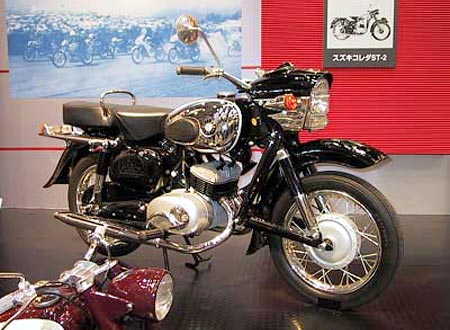
A 250cc twin, Colleda TT with an American style design was launched in 1956. The picture above shows the model shown at the ’99 Tokyo Motor Show (the historical section).
The Colleda TT is the predecessor of all Suzuki 250cc 2-stroke twins, including the T20, T250 and GT250. The air-cooled engine had a square 54 x 54 mm bore and stroke, the same as all of the models just mentioned. It also had new ”modern” floating swing arm with shock absorbers at the rear but the leading front fork design makes one to think of the early BMWs.
The slightly modernized Colleda COX-II was presented. The only difference I can spot on the pictures, in lack of technical info, is that the canter stand seems to made out of thinner material and a mudflap was attached to the the front mudguard.
A new version of the Colleda ST was launched with a modernized engine, now delivering 7 hp. Even the 100cc Porter Free had a more powerful engine in 1956. The Colleda ST-II received a same sort of fuel tank than the COX, making to models look even more like each other.
Colleda TT 1956 [ edit ]
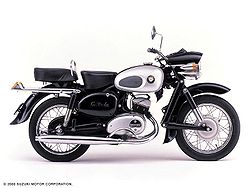
- Overall Length: 1 975 mm (77.8 in)
- Overall Width: 690 mm (27.2 in)
- Overall Height: 1 000 mm (39.4 in)
- Wheelbase: 1 280 mm (50.4 in)
- Dry Weight: 158 kg (348 lbs)
- Engine type: Air-cooled 247 cc parallel twin 2-stroke. 16 hp/ 6.000 rpm, 2,1 kg-m/ 4.000 rpm.
- Bore and stroke: 54 x 54 mm
- Compression ratio: 7 :1
- Tyres: 3.25-16
- Maximum speed: 130 kph
Colleda COX-II 1956 [ edit ]
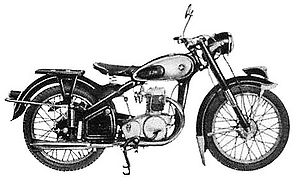
- Engine type: 123 cc side-valve single cylinder four-stroke.
- Three speeds, telescopic front forks and plunger rear suspension.
- The kick starter was placed on the left side of the engine on the four-stroke CO and COX models. The exhaust pipe ending is also different, shaped like is fish tail. Also to engine design was quite different from the two-strokers.
Colleda ST-II 1956 [ edit ]
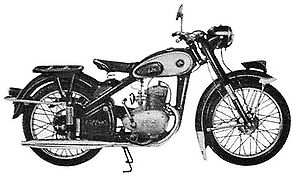
- Engine type: Air-cooled 123.18 cc single cylinder piston-valve 2-stroke. 7 hp.
- Bore and stroke: 52 x 58 mm
- Compression ratio: 7 :1
- Apart for the differences listed above, the Colleda COX-2 and Colleda ST-2 looked a lot like each other.
1957 [ edit ]
The 250 twin was replaced in 1957 with a similar styled but now single cylinder Colleda TP. Unfortunately I have no information or pictures of the model for the moment.
The Colleda ST was modernized every year, 1957-year’s ST-3 being the third model version of the popular bike, still using the hard plunger rear suspension. The headlight was redesigned, giving the bike a more sporty look. The engine had 52 x 58 mm bore and stroke.
Colleda ST-III 1957 [ edit ]
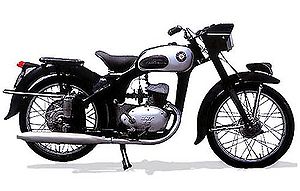
- Overall Length: 2 000 mm (78.7 in)
- Overall Width: 730 mm (28.7 in)
- Overall Height: 1 000 mm (39.4 in)
- Wheelbase: 1 270 mm (50.0 in)
- Dry Weight: 110 kg (242 lbs)
- Engine type: Air-cooled 123 cc single cylinder 2-stroke. 7 hp/ 5.500 rpm.
- 3 speeds.
- Bore and stroke: 52 x 58 mm
- Compression ratio: 7 :1
- Maximum speed: 85 kph
1958 [ edit ]
Suzuki introduced an assembly line to its factory in Hamamatsu in 1958. Three models were manufactured that year: the SM-1 Suzukimoped, the 125cc Colleda ST with 8 bhp and the new 250cc with 18 bhp, all single cylinder two-strokes. The 250cc twin, made in smaller quantities, was no longer manufactured as the production of the motorcycles was rationalized.
The 250cc TM was the cheapest Colleda model available in 1958. It used the powerful parallel twin engine from the Colleda TP (haven’t got any info or pictures of the model yet) and was a practical bike to transport goods with.
Colleda TM 1958 [ edit ]
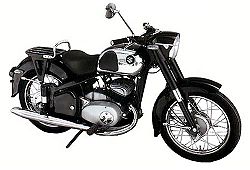
- Overall Length: 1 980 mm (78.0 in)
- Overall W >1959 [ edit ]
In 1959, the 6th modernized version of the 125cc ST had telescopic front fork and floating swing arm with shock absorbers, making riding more comfortable. The new-designed engine delivered now 8 hp. Popular among the youth.
A new 125cc twin was launched, the Colleda SB Seltwin. It had a quite sporty design and it was good for 110 kph. Seltwin was the first Japanese motorcycle model with an electric starter. A twin-engined 125cc motorcycle was an unusual concept in the fifties and still unusual in the seventies.
Colleda Selltwin Colleda ST-6A 1959 [ edit ]
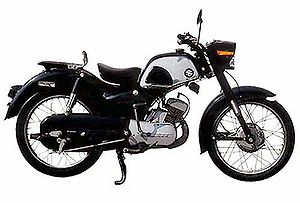
- Overall Length: 2 000 mm (78.7 in)
- Overall Width: 740 mm (29.1 in)
- Overall Height: 1 000 mm (39.4 in)
- Wheelbase: 1 280 mm (50.4 in)
- Dry Weight: 110 kg (242 lbs)
- Engine type: Air-cooled 123 cc 2-stroke. 8 hp/ 4.000 rpm, 1,07 kg-m/ 4.000 rpm.
- Bore and stroke: 52 x 58 mm
- Compression ratio: 7 :1
Colleda Seltwin Colleda Seltwin SB 1959 [ edit ]
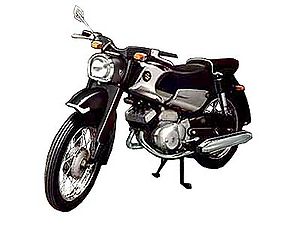
- Wheelbase: 1 295 mm (51.0 in)
- Dry Weight: 118 kg (260 lbs)
- Engine type: Air-cooled 123 cc parallel twin 2-stroke. 10 hp/ 8.000 rpm.
- Bore and stroke: 42.0 x 45.0 mm
- Compression ratio: 7,0 :1
- Maximum speed: 110 kph (68 mph)
- Tire size: 2.75-17
1960 [ edit ]
The 1960-year’s Colleda 250TA was the first motorcycle ever to use combination brakes, even now standard in only few motorcycle models, the Honda GoldWing being one of them. The TB used a hydraulic rear break and a link was attached to the brake pedal, making both the front and the rear brake to activate when pushing the pedal. The engine (actually not a square 54 x 54 mm bore and stroke) engine delivered 20 hp, giving the bike a 140 kph top speed. A scooter styled lower fairing was attached to the bike to protect the rider from moist and wind and the model had a dual seat, making it somewhat of a touring bike.
A 150cc sports version of the Seltwin was launched in 1960 with a dual seat and high-drawn exhaust pipe. The 125cc version of the model got an lower fairing, in style with the 250 TA.
Colleda 250 TA 1960 [ edit ]
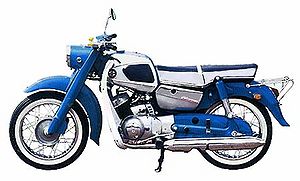
- Overall Length: 2 050 mm (80.7 in)
- Overall W >Colleda Seltwin 150SB-S [ edit ]
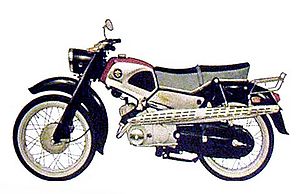
- Wheelbase: 1 295 mm (51.0 in)
- Dry Weight: 118 kg (260 lbs)
- Engine type: Air-cooled 150 cc parallel twin 2-stroke. 10 hp/ 8.000 rpm.
- Bore and stroke: 42.0 x 45.0 mm
- Compression ratio: 7,0 :1
Colleda Seltwin 125SB-2 [ edit ]
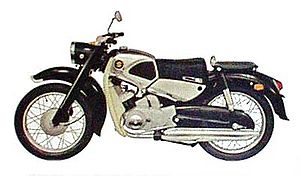
- Wheelbase: 1 295 mm (51.0 in)
- Dry Weight: 118 kg (260 lbs)
- Engine type: Air-cooled 123 cc parallel twin 2-stroke. 10 hp/ 8.000 rpm.
- Bore and stroke: 42.0 x 45.0 mm
- Compression ratio: 7,0 :1
1961 [ edit ]
Colleda 250 TB 1961 [ edit ]
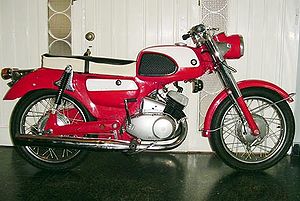
- Overall Length: 2 050 mm (80.7 in)
- Overall Width: 640 mm (25.2 in)
- Overall Height: 960 mm (37.8 in)
- Wheelbase: 1 350 mm (53.1 in)
- Engine type: Air-cooled 246 cc parallel twin, 2-stroke. 20 hp/ 6.000 rpm, 1,9 kg-m/ 6.000 rpm.
1962 [ edit ]
When the Cycle World magazine presented the Colleda 250TB in the USA in March 1962 (see above, click to enlarge), the bike was called the Suzuki TB but you could clearly see the Colleda emblem attached to the white sidepanel, althought there’s a Suzuki “S” logo on the engine. The 250TB was replaced in 1963 by the 250TC.
In Japan, two 125cc models with similar design but different engines were offered in 1962. The 125 SK had a twin engine with 11,5 hp and the 125 SL a single engine with 8 hp.
Colleda 250TB [ edit ]
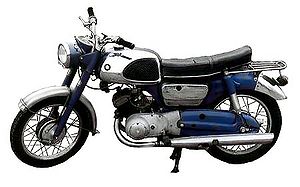
- Overall Length: 2 050 mm (80.7 in)
- Overall W >Colleda 125SK [ edit ]
- Engine type: Air-cooled 125 cc parallel twin, 2-stroke. 11,5 PS.
Colleda 125SL [ edit ]
- Dry Weight: 112 kg (246 lbs)
- Engine type: Air-cooled 125 cc single cylinder 2-stroke. 8,0 hp/ 6.000 rpm.
- Maximum speed: 56 mph, 4 speeds.
1963 [ edit ]
The Colleda 250TC was called 250TC El Camino in the USA. The Cycle World magazine published a four-page road test of the machine in October 1962 telling that the Suzuki was a lot of fun to ride with excellent handling, little vibrations and had a respectable top speed of 83 mph. It should be mentioned that the Colleda emblem on the side panel had been replaced with Suzuki emblem in America. The S (sports) version of the 250TC had a single passenger seat and weighed a few pounds less.
The 250TC was replaced with the Suzuki T10 in 1964 and a year later with the T20 that was a bike ahead of its time with 30 hp, automatic oiling, six speed gearbox, rev counter and a twin leading shoe brake at the front. Later the T20 was replaced with (technically almost unchanged) T250 and the GT250 with a single disc brake at the front.
Socata Rallye. Характеристики. Фото
Socata Rallye – семейство легкомоторных самолётов, выпускаемых французской авиастроительной компанией Socata в период с 1961 по 1982 год.
Фото Socata Rallye

Первые разработки самолётов семейства Socata Rallye начались в 1957 году, при этом, французские авиастроители пытались создать не только популярный летательный аппарат, который мог бы создать хорошую конкуренцию воздушным судам других авиапроизводителей, но и многоцелевой самолёт, подходящий как для пассажироперевозок, так и для других целей.
Socata Rallye MS.880 представляет собой базовую производственную версию легкомоторных самолётов этого семейства. Свой первый полёт этот летательный аппарат совершил в 1959 году, однако, из-за необходимости совершенствования конструкции и ряда лётно-технических характеристик, в массовое производство воздушное судно поступило только в 1961 году.
Socata Rallye фото

Базовая производственная модель Socata Rallye MS.880 представляла собой двухместное воздушное судно, эксплуатирующееся в основном частным владельцами, а также в качестве летательного аппарата для обучения будущих пилотов. Самолёт комплектовался одним поршневым авиадвигателем Continental O-200 (100 л.с.) и мог развивать скорость до 170 кмч.
Одним из недостатков этого самолёта являлась плохая манёвренность, не позволяющая резко изменить курс, либо же выполнять какие-либо аэробатические трюки, что впрочем не помешало достичь этому летательному аппарату определённой популярности у владельцев.
Socata Rallye

На смену базовой версии пришла модель Socata Rallye MS.881, отличительной особенностью которой стал новый поршневой двигатель Potez мощностью в 105 л.с., что естественно отразилось на лётно-технической характеристике этого воздушного судна. тем не менее, за всё время производства было построено всего лишь 12 самолётов этой версии.
Модель Socata Rallye MS.882 фактически ничем не отличалась от предшествующих версий в плане своего внешнего вида, однако, благодаря использованию более надёжной силовой установки представленной поршневым четырёхцилиндровым двигателем Lycoming мощностью в 115 л.с., самолёт стал более устойчивым к перегрузкам, увеличилась его максимальная скорость полёта, и был продлён эксплуатационный период.
Кабина Socata Rallye

1 января 1961 года свой первый полёт совершила версия Socata Rallye MS.885 Super Rallye, которая в отличии от предыдущих моделей стала трёхместной, что в гораздо большей мере удовлетворяла запросам владельцев. Помимо прочего, фюзеляж воздушного судна был несколько укреплён, а в качестве силовой установки стал использоваться двигатель Continental O-300, обладающий мощностью в 145 л.с.
Версия Socata Rallye MS.886 обладала двигателем Lycoming мощностью в 150 л.с., однако, из-за отсутствия должного спроса и многократно возросшей цены самолёта, было построено всего три экземпляра этой модификации.
Socata Rallye

Четырёхместная модификация Socata Rallye MS.890 Rallye Commodore обладала двигателем мощностью в 145 л.с., однако первоначально было построено всего лишь 8 самолётов, причём, главной причиной для прекращения производства этой модели послужил технический недочёт при разработке воздушного судна – максимальный взлётный вес самолёта не был рассчитан на подъём 4 человек и полёта на максимальной скорости.
Модели Socata Rallye MS.892 Rallye Commodore 150, Socata Rallye MS.892 Rallye Commodore 180 и Socata Rallye MS.894 Rallye Minerva были полностью основаны на 4-местной модификации, при этом, основным отличием их являлись мощные двигатели, позволяющие развивать тягу в 150, 180 и 220 л.с. соответственно.
Модель Socata Rallye 100 получила двигатель Continental O-200 мощностью в 100 л.с., и главным образом позиционировалась в качестве тренировочного воздушного судна для обучения и подготовки будущих пилотов. В отличии от базовой версии самолётов этого семейства, текущая модель стала гораздо более манёвренной и управляемой.
Модификация Socata Rallye 125 отличалась от предыдущей модели исключительно наличием более мощного двигателя (125 л.с.), что собственно наблюдалось и у версии Socata Rallye 235, однако здесь присутствовала гораздо более мощная силовая установка, развивающая 235 л.с., что позволяло самолёту разгоняться до скорости в 315 кмч.
Легкомоторный самолёт Socata Galopin представляет собой модернизированную модификацию модели Rallye 100 – здесь использовался двигатель мощностью в 110 л.с., ввиду чего самолёт именовался также не иначе как Socata Rallye 110.
Socata Garnement – усовершенствованная версия модели Socata Rallye 150, оборудованная двигателем мощностью в 155 л.с., более надёжным и простым в плане технического обслуживания.
Модель Socata Gaucho представляет собой специальную сельскохозяйственную версию самолёта, рассчитанную на перевозку только одного человека.
Модификации Socata Gailard, Socata Galerien, Socata Gabier представляют собой blynbxyst друг другу версии легкомоторного самолёта. Заменившие ввиду ряда незначительных изменений модели Socata Rallye 150180235.
Помимо прочего, самолёты семейства Socata Rallye выпускались также и по специальной лицензии на территории Польши.
- PZL-110 Koliber – аналог Socata Rallye 100, с двигателем Franklin 4A-235 мощностью в 116 л.с.;
- PZL-110 Koliber 150 – аналог модели Socata Rallye 150;
- PZL-110 Koliber 160;
- PZL-110 Koliber 235 – аналог модели Socata Rallye 235.
За всё время производства было построено более 3300 самолётов, из которых на сегодняшний день в эксплуатации до сих пор находится около 2500 летательных аппаратов.
Технические характеристики Socata Rallye.
- Экипаж: 1 человек;
- Пассажировместимость: 3 человека (В зависимости от модификации);
- Длина самолёта: 7,24 м. (В зависимости от модификации);
- Размах крыльев: 9,74 м. (В зависимости от модификации);
- Высота самолёта: 2,8 м. (В зависимости от модификации);
- Масса пустого самолёта: 570 кг. (В зависимости от модификации);
- Полезная нагрузка: 480 кг. (В зависимости от модификации);
- Максимальный взлётный вес: 1050 кг. (В зависимости от модификации);
- Крейсерская скорость: 225 кмч. (В зависимости от модификации);
- Максимальная скорость полёта: 240 кмч. (В зависимости от модификации);
- Максимальная дальность полёта: 1300 км. (В зависимости от модификации);
- Максимальная высота полёта: 3600 м. (В зависимости от модификации);
- Тип авиадвигателя: поршневой;
- Силовая установка: Lycoming O-360-A3A (В зависимости от модификации);
- Мощность: 180 л.с. (В зависимости от модификации).
Suzuki Colleda
You couldn’t find any Suzuki stickers or emblems on the motorcycles Suzuki built on the early models. No, the early models were given the name Colleda and the famous Suzuki ”S” appeared for the first time in 1959 and the Colleda brand name was replaced by Suzuki in the early 1960’s, the T10 being the first non-Colleda. Here’s some of the Suzuki’s Colleda models from the fifties and early sixties. I will add more models here when I find suitable pictures and some facts.
Contents
1954 [ edit ]
Apparently the word “Colleda” means something like “This is it!” or “This is the one!” in Japanese. The Japanese use that word when they find something special (the best) they have been looking for. (Thanks, Takeshi!)
Suzuki Loom Manufacturing Company (SJK) presented the side-valve powered Colleda CO in May 1954, the first real motorcycle from Suzuki. The single-cylinder 90cc four-stroke engine developed four horsepower and ran quite smoothly, thanks to its heavy fly wheel, attached to ignition magneto.
No driver’s license was needed at the time for riding the Colleda CO. The Japanese government had recently decided that no driver’s license were longer needed to ride a bike with an 4-stroke engine up to 90cc or a 2-stroke engine up to 60cc. That explains rather well Suzuki’s choice of engines for its first models on the market in 1954 – the Diamond Free motorized motorcycle with 58cc 2-stroke engine with 2 hp and the 90cc four-stroke with 4 hp.
The Colleda CO had a steel frame, telescopic front fork, shock absorbers on the rear wheel and coil spring-suspensioned seat. It had no turning lights but it did have a headlight and a rear light. It was the first Japanese motorcycle provided with a speedometer, built in the headlight. The built-in gearbox had three speeds. One source claim that the model had hydraulic brakes but I haven’t been able to confirm this.
The rigid frame and luggage carrier made the bike suitable for carrying of goods. They say that the 90cc Colleda sounded more than it actually performed, but the ”sound effects” and the rigid construction made the bike quite popular among Japanese customers.
Engine type: 90 cc side-valve single cylinder four-stroke. 4 hp.
1955 [ edit ]
It was not longer allowed to ride a 90cc four-stroke without a driver’s license in 1955 and that naturally affected the sales figures in negative direction. The 90cc Colleda CO must be one of the absolute rarest motorcycles Suzuki ever built. The model was soon discontinued and replaced by the 125cc version. But the four-stroke machines at the time were not as reliable as the more simple two-stroke machines and soon Suzuki discontinued even the 125 model. All the forces were concentrated in developing two-stroke engines. It took actually over 20 years before Suzuki built four-strokes again, after an unsuccessful attempt of using Wankel rotary engines.
The four-stroke models got company by the 102cc Porter Free and 123cc ST during 1955. Both models were two-strokers with steel frame, telescopic front forks and plunger rear suspension, similar to their predecessors. All of the Colleda two-stroke engines used the conventional piston valve construction, the rotary (reed) valve engines came much later.
The ST was the most successful of the models. It was a simple and affordable small motorcycle that was in sales of the model exceeded 100,000 units during the six years it was manufactured.
Colleda COX 1955 [ edit ]
Dry Weight: Engine type: 123 cc side-valve single cylinder four-stroke. Three speeds, telescopic front forks and plunger rear suspension.

Colleda ST 1955 [ edit ]
- Dry Weight: 95 kg (205 lbs)
- Engine type: Air-cooled 123.18 cc single cylinder piston-valve 2-stroke. 5,5 hp.
- Maximum Speed: 65 kph
- Bore and stroke: 52.0 x 58.0 mm
- Compression ratio: 9.5:1
- Clutch: wet multiple plate
- Gears: 4
- Tyres: 2.50-19

1956 [ edit ]

A 250cc twin, Colleda TT with an American style design was launched in 1956. The picture above shows the model shown at the ’99 Tokyo Motor Show (the historical section).
The Colleda TT is the predecessor of all Suzuki 250cc 2-stroke twins, including the T20, T250 and GT250. The air-cooled engine had a square 54 x 54 mm bore and stroke, the same as all of the models just mentioned. It also had new ”modern” floating swing arm with shock absorbers at the rear but the leading front fork design makes one to think of the early BMWs.
The slightly modernized Colleda COX-II was presented. The only difference I can spot on the pictures, in lack of technical info, is that the canter stand seems to made out of thinner material and a mudflap was attached to the the front mudguard.
A new version of the Colleda ST was launched with a modernized engine, now delivering 7 hp. Even the 100cc Porter Free had a more powerful engine in 1956. The Colleda ST-II received a same sort of fuel tank than the COX, making to models look even more like each other.
Colleda TT 1956 [ edit ]

- Overall Length: 1 975 mm (77.8 in)
- Overall Width: 690 mm (27.2 in)
- Overall Height: 1 000 mm (39.4 in)
- Wheelbase: 1 280 mm (50.4 in)
- Dry Weight: 158 kg (348 lbs)
- Engine type: Air-cooled 247 cc parallel twin 2-stroke. 16 hp/ 6.000 rpm, 2,1 kg-m/ 4.000 rpm.
- Bore and stroke: 54 x 54 mm
- Compression ratio: 7 :1
- Tyres: 3.25-16
- Maximum speed: 130 kph
Colleda COX-II 1956 [ edit ]

- Engine type: 123 cc side-valve single cylinder four-stroke.
- Three speeds, telescopic front forks and plunger rear suspension.
- The kick starter was placed on the left side of the engine on the four-stroke CO and COX models. The exhaust pipe ending is also different, shaped like is fish tail. Also to engine design was quite different from the two-strokers.
Colleda ST-II 1956 [ edit ]

- Engine type: Air-cooled 123.18 cc single cylinder piston-valve 2-stroke. 7 hp.
- Bore and stroke: 52 x 58 mm
- Compression ratio: 7 :1
- Apart for the differences listed above, the Colleda COX-2 and Colleda ST-2 looked a lot like each other.
1957 [ edit ]
The 250 twin was replaced in 1957 with a similar styled but now single cylinder Colleda TP. Unfortunately I have no information or pictures of the model for the moment.
The Colleda ST was modernized every year, 1957-year’s ST-3 being the third model version of the popular bike, still using the hard plunger rear suspension. The headlight was redesigned, giving the bike a more sporty look. The engine had 52 x 58 mm bore and stroke.
Colleda ST-III 1957 [ edit ]

- Overall Length: 2 000 mm (78.7 in)
- Overall Width: 730 mm (28.7 in)
- Overall Height: 1 000 mm (39.4 in)
- Wheelbase: 1 270 mm (50.0 in)
- Dry Weight: 110 kg (242 lbs)
- Engine type: Air-cooled 123 cc single cylinder 2-stroke. 7 hp/ 5.500 rpm.
- 3 speeds.
- Bore and stroke: 52 x 58 mm
- Compression ratio: 7 :1
- Maximum speed: 85 kph
1958 [ edit ]
Suzuki introduced an assembly line to its factory in Hamamatsu in 1958. Three models were manufactured that year: the SM-1 Suzukimoped, the 125cc Colleda ST with 8 bhp and the new 250cc with 18 bhp, all single cylinder two-strokes. The 250cc twin, made in smaller quantities, was no longer manufactured as the production of the motorcycles was rationalized.
The 250cc TM was the cheapest Colleda model available in 1958. It used the powerful parallel twin engine from the Colleda TP (haven’t got any info or pictures of the model yet) and was a practical bike to transport goods with.
Colleda TM 1958 [ edit ]

- Overall Length: 1 980 mm (78.0 in)
- Overall W >1959 [ edit ]
In 1959, the 6th modernized version of the 125cc ST had telescopic front fork and floating swing arm with shock absorbers, making riding more comfortable. The new-designed engine delivered now 8 hp. Popular among the youth.
A new 125cc twin was launched, the Colleda SB Seltwin. It had a quite sporty design and it was good for 110 kph. Seltwin was the first Japanese motorcycle model with an electric starter. A twin-engined 125cc motorcycle was an unusual concept in the fifties and still unusual in the seventies.
Colleda Selltwin Colleda ST-6A 1959 [ edit ]

- Overall Length: 2 000 mm (78.7 in)
- Overall Width: 740 mm (29.1 in)
- Overall Height: 1 000 mm (39.4 in)
- Wheelbase: 1 280 mm (50.4 in)
- Dry Weight: 110 kg (242 lbs)
- Engine type: Air-cooled 123 cc 2-stroke. 8 hp/ 4.000 rpm, 1,07 kg-m/ 4.000 rpm.
- Bore and stroke: 52 x 58 mm
- Compression ratio: 7 :1
Colleda Seltwin Colleda Seltwin SB 1959 [ edit ]

- Wheelbase: 1 295 mm (51.0 in)
- Dry Weight: 118 kg (260 lbs)
- Engine type: Air-cooled 123 cc parallel twin 2-stroke. 10 hp/ 8.000 rpm.
- Bore and stroke: 42.0 x 45.0 mm
- Compression ratio: 7,0 :1
- Maximum speed: 110 kph (68 mph)
- Tire size: 2.75-17
1960 [ edit ]
The 1960-year’s Colleda 250TA was the first motorcycle ever to use combination brakes, even now standard in only few motorcycle models, the Honda GoldWing being one of them. The TB used a hydraulic rear break and a link was attached to the brake pedal, making both the front and the rear brake to activate when pushing the pedal. The engine (actually not a square 54 x 54 mm bore and stroke) engine delivered 20 hp, giving the bike a 140 kph top speed. A scooter styled lower fairing was attached to the bike to protect the rider from moist and wind and the model had a dual seat, making it somewhat of a touring bike.
A 150cc sports version of the Seltwin was launched in 1960 with a dual seat and high-drawn exhaust pipe. The 125cc version of the model got an lower fairing, in style with the 250 TA.
Colleda 250 TA 1960 [ edit ]

- Overall Length: 2 050 mm (80.7 in)
- Overall W >Colleda Seltwin 150SB-S [ edit ]

- Wheelbase: 1 295 mm (51.0 in)
- Dry Weight: 118 kg (260 lbs)
- Engine type: Air-cooled 150 cc parallel twin 2-stroke. 10 hp/ 8.000 rpm.
- Bore and stroke: 42.0 x 45.0 mm
- Compression ratio: 7,0 :1
Colleda Seltwin 125SB-2 [ edit ]

- Wheelbase: 1 295 mm (51.0 in)
- Dry Weight: 118 kg (260 lbs)
- Engine type: Air-cooled 123 cc parallel twin 2-stroke. 10 hp/ 8.000 rpm.
- Bore and stroke: 42.0 x 45.0 mm
- Compression ratio: 7,0 :1
1961 [ edit ]
Colleda 250 TB 1961 [ edit ]

- Overall Length: 2 050 mm (80.7 in)
- Overall Width: 640 mm (25.2 in)
- Overall Height: 960 mm (37.8 in)
- Wheelbase: 1 350 mm (53.1 in)
- Engine type: Air-cooled 246 cc parallel twin, 2-stroke. 20 hp/ 6.000 rpm, 1,9 kg-m/ 6.000 rpm.
1962 [ edit ]
When the Cycle World magazine presented the Colleda 250TB in the USA in March 1962 (see above, click to enlarge), the bike was called the Suzuki TB but you could clearly see the Colleda emblem attached to the white sidepanel, althought there’s a Suzuki “S” logo on the engine. The 250TB was replaced in 1963 by the 250TC.
In Japan, two 125cc models with similar design but different engines were offered in 1962. The 125 SK had a twin engine with 11,5 hp and the 125 SL a single engine with 8 hp.
Colleda 250TB [ edit ]

- Overall Length: 2 050 mm (80.7 in)
- Overall W >Colleda 125SK [ edit ]
- Engine type: Air-cooled 125 cc parallel twin, 2-stroke. 11,5 PS.
Colleda 125SL [ edit ]
- Dry Weight: 112 kg (246 lbs)
- Engine type: Air-cooled 125 cc single cylinder 2-stroke. 8,0 hp/ 6.000 rpm.
- Maximum speed: 56 mph, 4 speeds.
1963 [ edit ]
The Colleda 250TC was called 250TC El Camino in the USA. The Cycle World magazine published a four-page road test of the machine in October 1962 telling that the Suzuki was a lot of fun to ride with excellent handling, little vibrations and had a respectable top speed of 83 mph. It should be mentioned that the Colleda emblem on the side panel had been replaced with Suzuki emblem in America. The S (sports) version of the 250TC had a single passenger seat and weighed a few pounds less.
The 250TC was replaced with the Suzuki T10 in 1964 and a year later with the T20 that was a bike ahead of its time with 30 hp, automatic oiling, six speed gearbox, rev counter and a twin leading shoe brake at the front. Later the T20 was replaced with (technically almost unchanged) T250 and the GT250 with a single disc brake at the front.
Гусеничный мотоцикл Tractorcycle 1938 г.
В 1938 году французский инженер Леэтр представил свой взгляд на мотоциклы под названием Tractorcycle. Сделав свой мотоцикл целиком на гусеничном ходу.
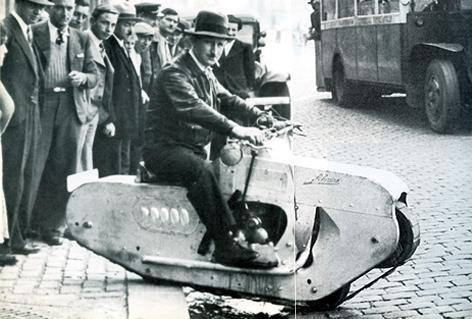
Казалось бы, легкая броня и высокая проходимость должны были сделать эту модель идеальным военным мотоциклом, что и изобразил художник журнала Modern Mechanix.
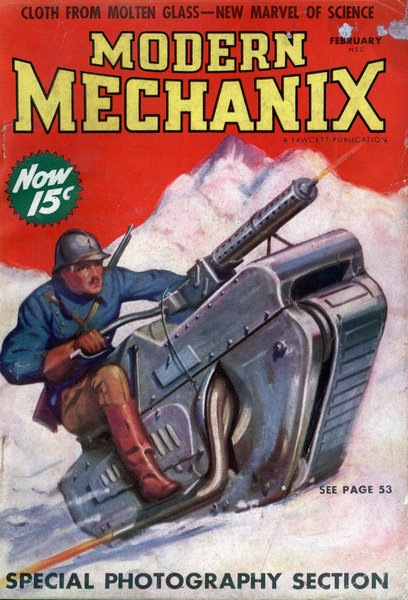
Но существовал ряд серьезных недостатков: большой вес (400 килограммов), низкая скорость (при моторе объемом 500 кубических сантиметров он развивал скорость всего лишь 30 км/ч) и плохая управляемость.

Так как поворот мотоцикла осуществлялся изгибанием гусеницы, при повороте мотоцикл был крайне неустойчив. Не могу представить себе, как все это работало на практике.

Позже Леэтр добавил в свою конструкцию боковые колеса, но армия так и не заинтересовалась его разработкой.

Всего было построено 2 прототипа, один из которых передали французской армии для тестирования.


А Вермахт пошел дальше и разработал SdKfz 2, известный также, как Kettenkrad HK 101 – полугусеничный мотоцикл высокой проходимости, массово выпускавшийся в Германии в годы Второй мировой войны.

Изначально разрабатывался для использования в парашютно-десантных и горно-егерских дивизиях люфтваффе и вермахта, однако благодаря высоким динамическим характеристикам снискал большую популярность в немецкой армии и широко применялся всеми её подразделениями. Всего с 1940 по 1945 годы фирмами NSU и Stoewer было выпущено 8871 мотоциклов. Судя по отзывам солдат Вермахта, эта машина была незаменима в СССР в холодное время года и осенней распутицы.

В ходе испытаний выяснилось, что этот мотоцикл может с успехом применяться не только как буксировщик легких артиллерийских орудий, но и как прокладчик кабеля и буксировщик самолетов.
Разработанный в качестве легкого тягача для горнострелковых войск полугусеничный мотоцикл NSU быстро нашёл применение во всех видах вооруженных сил Германии, где использовался для буксировки лёгких горных и зенитных пушек, минометов, самолетов, катушек с телефонным кабелем и различного рода прицепов.
Кроме того, стандартный заводской комплект включал в себя навесную броню, после чего тягач превращался в полугусеничный БРДМ, вооруженную пулемётом.


Уже после окончания войны из оставшегося задела деталей в период с 1945 по 1949 годы было собрано ещё около 550 машин, применявшихся в народном хозяйстве до 1950-х годов.


